Abstract
Familial intrahepatic cholestasis 1 (FIC1) disease is a genetic disorder characterized by hepatic and gastrointestinal disease due to ATP8B1 deficiency, often requiring liver transplantation (LT). Extrahepatic symptoms, such as diarrhea, malabsorption, and failure to thrive, do not improve and instead may be aggravated after LT. We describe a patient with FIC1 disease who underwent LT at 2 years, 8 months of age. After LT, the child developed severe refractory diarrhea and failed to thrive. The response to bile acid resins was unsatisfactory, and the parents declined our recommendation for partial external biliary diversion (PEBD). Quality of life was extremely impaired, especially due to severe diarrhea, making school attendance impossible. Attempting to reduce the total bile acids, we initiated off-label use of the ileal bile acid transporter (IBAT) inhibitor Elobixibat (Goofice™), later converted to Odevixibat (Bylvay™). After six months of treatment, the patient showed less stool output, increased weight and height, and improved physical energy levels. The child could now pursue higher undergraduate education. In our patient with FIC1 disease, the use of IBAT inhibitors was effective in treating chronic diarrhea and failure to thrive. This approach is novel; further investigations are needed to clarify the exact mode of action in this condition.
1. Introduction
Familial intrahepatic cholestasis 1 (FIC1) disease is a genetic disorder caused by variants in ATPase Phospholipid Transporting 8B1 (ATP8B1), often requiring liver transplantation (LT) during childhood [1]. ATP8B1 is expressed in various tissues, including the liver and intestines [2]. Extrahepatic symptoms, such as diarrhea and malabsorption, do not improve and are often aggravated after LT as a consequence of (presumed) chologenic diarrhea and impaired interaction between the transplanted liver and native bowel. ATP8B1 deficiency reduces apical-membrane stability in various polarized cell types [3]. Due to normal liver ATP8B1 function in the transplanted liver, the ATP8B1-deficient intestinal epithelium encounters a much higher chyme bile acid (BA) concentration than before LT. For healthy intestines, this is not a problem, but for intestines with FIC1 disease, their membrane vulnerability to BA results in chologenic diarrhea [4].
In 2021, the Kyoto group published data on 12 FIC1 disease patients, where 11 of the children suffered from chronic diarrhea after LT [5]. The second severe problem was liver steatosis and fibrosis, possibly caused by malabsorption, secondary to refractory diarrhea [6]. To date, medication such as bile acid resins seems to help in diarrhea, and especially surgical interventions, such as partial external biliary diversion (PEBD) after LT, can effectively alleviate diarrhea and can also reduce graft steatosis and inflammation [7,8,9]. Some centers perform a total internal biliary diversion at the time of LT [10].
We report on a patient with FIC1 disease who underwent LT at 2 years 8 months of age and developed severe refractory diarrhea early on. As the response to bile acid resins was unsatisfactory, and parents did not agree with an attempt at PEBD, we sought ethical approval for the off-label use of a high-dose ileal bile acid transporter inhibitor Elobixibat (Goofice™). After an encouraging clinical response, the child was converted to Odevixibat (Bylvay™) when compassionate use became available.
Elobixibat, Odevixibat, or Maralixibat (Livmarli™), developed by different companies, are novel, orally available, selectively reversible IBAT inhibitors. Elobixibat is less potent than Odevixibat and is licensed as an anti-constipation treatment in Japan. They act locally in the gut via IBAT inhibition. First, they act in lowering BAs plasma or serum levels by the downregulation of BA reuptake in the distal ileum. Second, they act via improved colon clearance of BAs [11,12,13]. Odevixibat is approved for the treatment of progressive familial intrahepatic cholestasis in children older than 3 months [14]. Children with Alagille syndrome older than 1 year can be treated with Maralixibat in the case of cholestatic pruritus [13].
The enterohepatic circulation of BAs depends on the absorption of BA in the terminal ileum and colon. BAs play an essential role in the absorption and solubilization of cholesterol, dietary lipids, and fat-soluble vitamins [15]. Ninety-five percent of the BAs are reclaimed by the IBAT abundantly expressed in the terminal ileum [16]. IBAT inhibitors modulate enterohepatic BA circulation, enhancing the delivery of BAs to the colon, where they induce secretory and motor effects. Secondary effects of the inhibition of BA absorption are reduced activation of the farnesoid X receptor, decreased secretion of fibroblast growth factor-19 into the portal circulation, and increased BA synthesis [17]. During this process, the hepatic synthesis of BA is upregulated on account of the maintenance of enterohepatic circulation homeostasis [18]. Additionally, the abundant synthesis of cholesterol derivatives leads to the depletion of cholesterol stores in the liver, which simultaneously stimulates the expression of low-density lipoprotein (LDL) receptors on hepatocytes and reduces the level of serum LDL [19]. In trials, an increase in C4 (7α-hydroxy-4-cholesten-3-one) values were observed, which is an intermediate plasma marker in BA synthesis [20].
Another point is the influence of bile acids on the microbiome and their antibacterial effect. The molecular structures of primary BAs are modified by the gut bacteria and give rise to secondary BAs or other BA forms. Low levels of BAs in the gut appear to trigger an overgrowth of bacteria, with the consequence of inflammation and bacterial translocation [21]. The use of IBAT inhibitors changes the composition of the BA pool [22]. This can be seen in studies of BA composition in plasma and feces when using IBAT inhibitors. A substantial decrease in secondary and conjugate BAs was found [12].
Side effects reported in other studies are not serious. Maralixibat was well tolerated, and the most frequent adverse events were gastrointestinal [23]. The Elobixibat safety report on Japanese patients with chronic constipation (n = 979) showed that the proportion of adverse reactions was 12.4%, with diarrhea (2.9%), abdominal pain (1.4%), and constipation (0.8%) being the most frequent adverse events [24]. Odevixibat may decrease the adsorption of fat-soluble vitamins and may cause liver test abnormalities [14,25].
2. Case Report
We report on a male infant born by secondary cesarean section at term to healthy Caucasian and nonrelated parents with a birth weight of 3940 g. The pregnancy was uneventful, and there was no family history of liver disease. At three months of age, he developed gGT-negative cholestasis. FIC1 disease was genetically confirmed, revealing a homozygous nonsense variant (c.2788C>T, p.R930STOP) in ATB8B1. A liver biopsy performed at 4 months of age confirmed that the underlying diagnosis and fibrosis stage was ISHAK Fibrosis Score [26] with ISHAK F4. At this time, growth and development were normal on breastfeeding and formula milk; stool frequency was age-related with colored stools (laboratory values over time in Appendix A).
At the age of 2 years and 1 month, the patient received partial external biliary diversion surgery (PEBD) because of persistent cholestasis and severe pruritus. In line with the previously performed liver biopsy, the fibrosis stage was still ISHAK F4. Following PEBD, postoperative complications arose, such as bleeding from the stoma with revision operation, cholangitis, high fluid loss with pronounced hyponatremia, and failure to thrive. As a further problem, signs of portal hypertension occurred due to progressive liver cirrhosis. A deceased donation of a full-size liver was performed at the age of 2 years and 8 months (Figure 1). Tacrolimus was chosen as a monotherapy immunosuppressant. Following LT, pruritus disappeared, and serum bilirubin concentration normalized. However, diarrhea progressively worsened within the first weeks following LT, with 10–13 liquid stools/day. Neither treatment with a bile acid sequestrant, an opioid-receptor agonist, an inhibitor of enkephalinase enzymes, or substitution of a pancreatic enzyme led to any significant change in stool consistency or frequency over the years after LT (Figure 2). The patients’ main problems were severe electrolyte derailments with dehydration and hospitalization in the 7 years after LT. Problems of hyponatremia, hypochloremia, and hypokalemia made a continuous oral substitution necessary. For this challenging management, the patient required a feeding tube (percutaneous endoscopic gastrostomy). Additionally, the patient suffered significantly from failure to thrive, beginning at the age of 5 years (Figure 3).
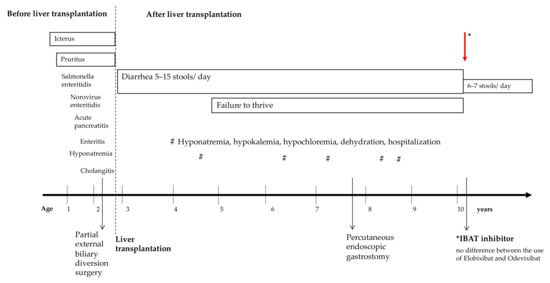
Figure 1.
Life before and after liver transplantation over 10 years. IBAT, ileal bile acid transporter inhibitor.
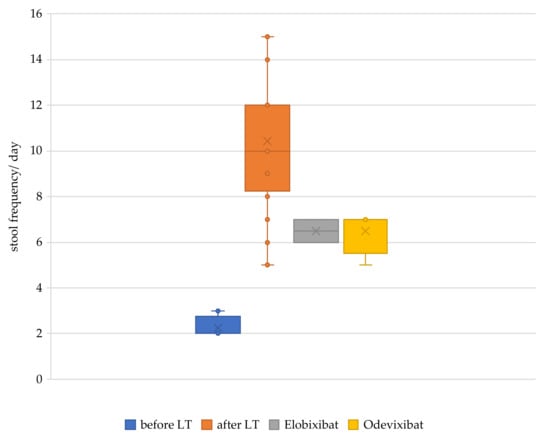
Figure 2.
Daily stool frequency before liver transplantation, after liver transplantation, and with IBAT inhibitor. LT, liver transplantation; IBAT, ileal bile acid transporter inhibitor.
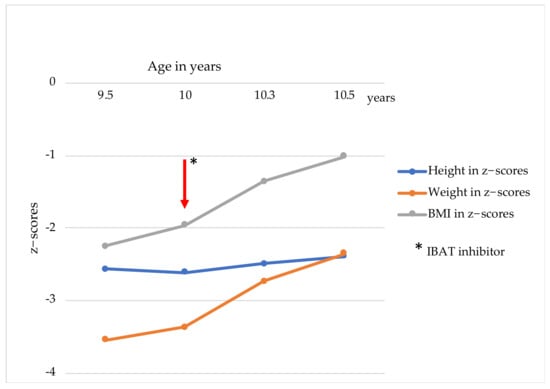
Figure 3.
Weight, height, and BMI in z−scores before and with IBAT inhibitor. IBAT, ileal bile acid transporter inhibitor; BMI, body mass index.
At the age of 10 years, quality of life was extremely impaired, and the child was not able to attend normal school because of uncontrollable and frequent bowel movements. As the parents did not consent to repeat biliary diversion surgery to remedy chronic diarrhea, a therapy attempt with an IBAT inhibitor Elobixibat was made. After starting the treatment with 25 mg Elobixibat once a day, stool frequency decreased from a maximum of 15 stools/day to 6–7 stools/day. After one month, a change to Odevixibat on compassionate use became available. The initial dose of Odevixibat was 40 µg/kg/day and, while well-tolerated, was increased to 120 µg/kg/day once a day. In accordance with the safety profile, bilirubin, liver enzymes, and fat-soluble vitamins were monitored. There was no increase in liver enzymes or lack of fat-soluble vitamins during treatment (Table 1). There was no change in co-medication or substitution of electrolytes. A BA sequestrant was given in the same dosage all through this time. After 5 months of treatment, the family decided to change from a granule preparation of Tacrolimus to a prolonged-release preparation of the drug. The daily tacrolimus dosage whilst using IBAT inhibition was increased from 1.6 mg up to 6 mg to reach consistent therapeutic trough levels.

Table 1.
Liver enzymes, fat-soluble vitamins before and during treatment. IBAT, ileal bile acid transporter inhibitor; ALAT, alanine aminotransferase; ASAT, aspartate aminotransferase; INR, international normalized ratio.
The family noted a further improvement in stool frequency, appetite, and physical energy levels during the treatment with Elobixibat and later with Odevixibat. After seven months of treatment with an IBAT inhibitor, stool frequency has been stable at 6–7 times/day, making it possible for the child to partake in regular school lessons for the first time. Additionally, the patient is still showing improved weight development, with 24.5 kg (first percentile (P), −2.35 z)), height increase to 127 cm (first percentile (P), −2.39 z), and a significant change in BMI at 15.2 kg/m² (16P, −1.01 z) (Figure 3).
Total plasma BAs were reduced by approximately 56% after 7 months of treatment with IBAT inhibitors. The composition of plasma BAs changed following Odevixibat administration, with a substantial decrease in taurocholic acid (TCA) and glycocholic acid (GCA), and an increase in levels of chenodeoxycholic acid (CDCA) and deoxycholic acid (DCA) (Figure 4, Figure 5 and Figure 6).
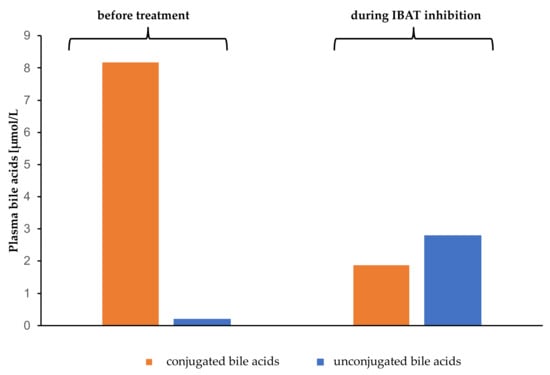
Figure 4.
Conjugated and unconjugated plasma bile acids before and during treatment with IBAT inhibitors. IBAT, ileal bile acid transporter inhibitor.
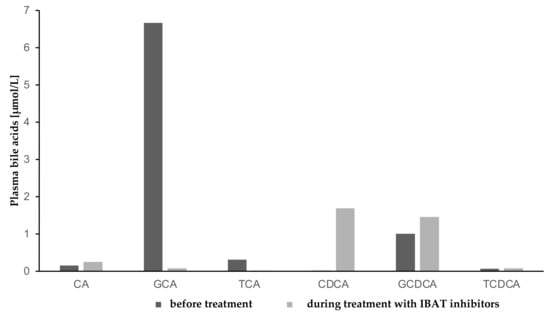
Figure 5.
Primary bile acids and their conjugates in plasma before and during treatment with IBAT inhibitors. CA, Chenodeoxycholic acid; GCA, Glycocholic acid; TCA, Taurocholic acid; CDCA, Chenodeoxycholic acid; GCDCA, Glycochenodeoxycholic acid; TCDCA, Taurochenodeoxycholic acid, IBAT, ileal bile acid transporter inhibitor.
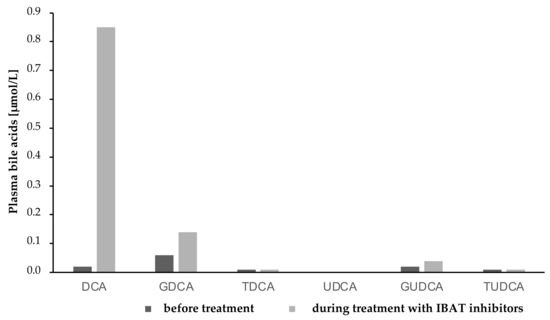
Figure 6.
Secondary bile acids and their conjugates in plasma before and during treatment with IBAT inhibitors. DCA, Deoxycholic acid; GDCA, Glycodeoxycholic acid; TDCA, Taurodeoxycholic acid; UDCA, Ursodeoxycholic acid; GUDCA, Glycoursodeoxycholic acid; TUDCA, Tauroursodeoxycholic acid; IBAT, ileal bile acid transporter inhibitor.
3. Discussion
We report on the successful medical treatment of a child with FIC1 disease suffering from debilitating diarrhea and failure to thrive post-liver transplantation. Intervention with IBAT inhibition rapidly stabilized the child and improved physical energy levels, appetite, and school performance.
All currently available medication failed in our patient, and the parents refused surgical options. We therefore sought ethical approval to try a therapeutic attempt of IBAT inhibition. We began with Elobixibat as the only available and approved IBAT inhibitor at a dose 5 x times higher than the recommended starting dose in adults in order to mimic the effects that the IBAT inhibitors Odevixibat and Maralixibat have on the liver. In our patient, we saw a clear improvement in quality of life, primarily due to the decrease in diarrhea frequency and weight gain when taking IBAT inhibitors.
There are several possible explanations as to why diarrhea occurs after LT in ATP8B1-deficient patients. One is that direct BA toxicity is responsible, as both biliary diversion and BA binding resins seem to be effective treatments [27]. Partial biliary diversion diverts bile flow from the gut, thereby reducing high BA levels in chyme and most likely preventing high BA levels in the portal system and the liver.
Knisely et al. argue that ATP8B1 deficiency disrupts farnesoid X receptor (FXR) synthesis and activation. In interaction with BA as a coligand, FXR normally regulates the synthesis of the apical sodium-dependent BA transporter (ASBT = IBAT, SLC10A2), which imports BA into the enterocytes. Furthermore, it regulates the synthesis of fibroblast growth factor 19 (FGF19), which suppresses the synthesis of hepatic BAs. ATP8B1-diseased bowel and liver may be primarily FXR-deficient or unable to activate FXR. Accordingly, this leads to LT and the fact that when physiological levels of BA challenge the intestine, inappropriately low levels of FGF19 and inappropriately high levels of BA (via unregulated ASBT) are released into the portal venous blood. As a result, the liver can secrete large amounts of both recirculated and newly synthesized BA, adding even more BA to the enterohepatic circulation [4].
Graffner et al. showed a substantial decrease in total BA in plasma when using IBAT inhibitors in healthy volunteers [12]. We saw the same effect in our patient, with decreasing total BA in plasma during treatment with Odevixibat and a significant change of BA composition in plasma when using IBAT inhibitors. In contrast to Graffner’s results, our patient showed a substantial decrease in primary GCA and TCA and an increase in the primary, unconjugated BA CDCA and secondary BA DCA. It must be taken into account that our patient, with underlying ATP8B1 deficiency, was treated with IBAT inhibitors after LT, and the cohort which Graffner examined were healthy adults. We assume a residual function of the ileal bile acid receptor in our patient, which could have been blocked by the medication.
Partial biliary diversion in ATP8B1-deficient patients who undergo LT seems efficacious in both diarrhea and allograft steatosis, as it diverts bile flow from the gut, thereby reducing high BA levels in chyme and, most likely, preventing high BA levels in the portal system and the liver. As a nonsurgical approach, IBAT inhibitors are an alternative way of disrupting enterohepatic BA circulation. They work by inhibiting the IBAT that reabsorbs BA from the intestines. IBAT inhibition has been shown to reduce serum bile acids and pruritus in trials in pediatric cholestatic liver diseases [28]. Effects of Odevixibat and Maralixibat on BA in cholestatic Alagille Syndrome patients have been thoroughly demonstrated [29,30]. Karpen and colleagues discussed the novel potential of IBAT inhibitors such as Odevixibat or Maralixibat for use in children with biliary atresia as a means to reduce hepatic bile acid concentration after Kasai portoenterostomy. By reducing the return of bile acids to the cholestatic liver, IBAT inhibitors may potentially lessen or delay liver damage associated with the hepatotoxicity and cholangiopathy of bile acid accumulation [31]. In 2020, Slatventinsky and Sturm described a patient with PFIC type 2 and severe pruritus. Both treatment with Odevixibat and PEBD resulted in a similar normalization of serum BA levels as well as a reduction in pruritus and improvement in sleep quality. Therefore, Odevixibat may be potentially equivalent to surgical PEBD in reducing serum BAs and cholestatic pruritus [32]. We therefore assume that the same effect that leads to a reduction in the bile acid pool due to PEBD is present in IBAT-inhibitor-treated patients and, thus, has an effect on chologenic diarrhea, as seen in our patient.
4. Conclusions
To date, partial biliary diversion in patients with FIC1 disease who undergo LT appears to be efficacious in treating both diarrhea and allograft steatosis. In our patient, a similar clinical response could be observed with the use of different IBAT inhibitors. This approach is novel, and it proved effective in terms of clinical outcomes, such as decreased daily stool frequency, weight and appetite gain, increased physical energy levels, and overall quality of life.
Author Contributions
The patient and parents were informed of the therapy attempt, and written, informed consent was obtained by U.B. Conceptualization: J.O. and U.B.; formal analysis, J.O. and D.H.; investigation, J.O.; methodology, J.O., E.-D.P. and U.B.; project administration, U.B.; software, J.O.; supervision, U.B.; validation, J.O. and U.B.; writing—original draft, J.O.; writing—review and editing, N.J., E.-D.P., I.G., F.M., T.L., H.N., D.H., V.K., E.J. and U.B. All authors have read and agreed to the published version of the manuscript.
Funding
This research was supported by BMBF through HiChol (1GM1904 A&B) to E.-D.P., V.K., and U.B.
Institutional Review Board Statement
The healing attempt was submitted to the ethics committee of the Hannover Medical School. There was informed consent from the parents, including for the off-label use.
Informed Consent Statement
Informed consent was obtained from parents.
Data Availability Statement
Data are available from the corresponding author on request.
Acknowledgments
The authors would like to thank Angela Bain-Emslie for language editing.
Conflicts of Interest
Ulrich Baumann is a consultant for Albireo Pharma and Mirum Pharma and has also received research grants and speaker fees from both companies. Verena Keitel received speaker’s reimbursement from the Falk Foundation, Albireo, Abbvie, and CSL Behring.
Appendix A

Table A1.
Liver enzymes, fat-soluble vitamins (under substitution) at the age of 1 year, before PEBD and before LT. PEBD, partial external biliary diversion; LT, liver transplantation; ALAT, alanine aminotransferase; ASAT, aspartate aminotransferase; INR, international normalized ratio.
Table A1.
Liver enzymes, fat-soluble vitamins (under substitution) at the age of 1 year, before PEBD and before LT. PEBD, partial external biliary diversion; LT, liver transplantation; ALAT, alanine aminotransferase; ASAT, aspartate aminotransferase; INR, international normalized ratio.
| Laboratory Parameters | Age of 1 Year | Before PEBD | Before LT | Normal Range |
|---|---|---|---|---|
| Bilirubin (µmol/L) | 71 | 170 | 70 | 3–17 |
| ALAT (U/I) | 39 | 72 | 56 | <35 |
| ASAT (U/I) | 94 | 147 | 113 | <45 |
| INR | 1.11 | 1.20 | 1.25 | 0.90–1.25 |
| Vitamin A (mg/L) | 0.39 | 0.17 | 0.33 | 0.3–0.06 |
| Vitamin E (mg/L) | 13.34 | 7.36 | 5.65 | 3–9 |
| 25-OH-D3 (ng/mL) | n.d. | 13.3 | 32.0 | 20–70 |
References
- Chen, H.-L.; Wu, S.-H.; Hsu, S.-H.; Liou, B.-Y.; Chen, H.-L.; Chang, M.-H. Jaundice revisited: Recent advances in the diagnosis and treatment of inherited cholestatic liver diseases. J. Biomed. Sci. 2018, 25, 1–13. [Google Scholar] [CrossRef] [PubMed] [Green Version]
- Bull, L.N.; Van Eijk, M.J.T.; Pawlikowska, L.; Deyoung, J.A.; Juijn, J.A.; Liao, M.; Klomp, L.W.J.; Lomri, N.; Berger, R.; Scharschmidt, B.R.; et al. A gene encoding a P-type ATPase mutated in two forms of hereditary cholestasis. Nat. Genet. 1998, 18, 219–224. [Google Scholar] [CrossRef]
- Verhulst, P.M.; van der Velden, L.M.; Oorschot, V.; van Faassen, E.E.; Klumperman, J.; Houwen, R.H.J.; Pomorski, T.G.; Holthuis, J.C.M.; Klomp, L.W.J. A flippase-independent function of ATP8B1, the protein affected in familial intrahepatic cholestasis type 1, is required for apical protein expression and microvillus formation in polarized epithelial cells. Hepatology 2010, 51, 2049–2060. [Google Scholar] [CrossRef]
- Knisely, A.; Houwen, R.H. Liver Steatosis and Diarrhea After Liver Transplantation for Progressive Familial Intrahepatic Cholestasis Type 1: Can Biliary Diversion Solve These Problems? J. Pediatr. Gastroenterol. Nutr. 2020, 72, 341–342. [Google Scholar] [CrossRef]
- Okamoto, T.; Sonoda, M.; Ogawa, E.; Ito, S.; Togawa, T.; Hayashi, H.; Okajima, H.; Uemoto, S. Long-term Outcomes of Living-donor Liver Transplantation for Progressive Familial Intrahepatic Cholestasis Type 1. J. Pediatr. Gastroenterol. Nutr. 2020, 72, 425–429. [Google Scholar] [CrossRef]
- Miyagawa-Hayashino, A.; Egawa, H.; Yorifuji, T.; Hasegawa, M.; Haga, H.; Tsuruyama, T.; Wen, M.-C.; Sumazaki, R.; Manabe, T.; Uemoto, S. Allograft steatohepatitis in progressive familial intrahepatic cholestasis type 1 after living donor liver transplantation. Liver Transplant. 2009, 15, 610–618. [Google Scholar] [CrossRef] [PubMed]
- Bull, L.N.; Thompson, R. Progressive Familial Intrahepatic Cholestasis. Clin. Liver Dis. 2018, 22, 657–669. [Google Scholar] [CrossRef] [Green Version]
- Jankowska, I.; Pawłowska, J.; Szymczak, M.; Ismail, H.; Broniszczak, D.; Cielecka-Kuszyk, J.; Socha, P.; Jarzębicka, D.; Czubkowski, P. A Report of 2 Infant Siblings with Progressive Intrahepatic Familial Cholestasis Type 1 and a Novel Homozygous Mutation in the ATP8B1 Gene Treated with Partial External Biliary Diversion and Liver Transplant. Am. J. Case Rep. 2021, 22, e932374-1–e932374-7. [Google Scholar] [CrossRef]
- Alrabadi, L.S.; Morotti, R.A.; Valentino, P.L.; Rodriguez-Davalos, M.I.; Ekong, U.D.; Emre, S.H. Biliary drainage as treatment for allograft steatosis following liver transplantation for PFIC-1 disease: A single-center experience. Pediatr. Transplant. 2018, 22, e13184. [Google Scholar] [CrossRef] [PubMed]
- Mali, V.P.; Fukuda, A.; Shigeta, T.; Uchida, H.; Hirata, Y.; Rahayatri, T.H.; Kanazawa, H.; Sasaki, K.; Goyet, J.D.V.D.; Kasahara, M. Total internal biliary diversion during liver transplantation for type 1 progressive familial intrahepatic cholestasis: A novel approach. Pediatr. Transplant. 2016, 20, 981–986. [Google Scholar] [CrossRef]
- Wong, B.S.; Camilleri, M. Elobixibat for the treatment of constipation. Expert Opin. Investig. Drugs 2012, 22, 277–284. [Google Scholar] [CrossRef] [PubMed]
- Graffner, H.; Gillberg, P.; Rikner, L.; Marschall, H.-U. The ileal bile acid transporter inhibitor A4250 decreases serum bile acids by interrupting the enterohepatic circulation. Aliment. Pharmacol. Ther. 2015, 43, 303–310. [Google Scholar] [CrossRef] [PubMed]
- Shirley, M. Maralixibat: First Approval. Drugs 2021, 82, 71–76. [Google Scholar] [CrossRef] [PubMed]
- Deeks, E.D. Odevixibat: First Approval. Drugs 2021, 81, 1781–1786. [Google Scholar] [CrossRef]
- Reshetnyak, V.I. Physiological and molecular biochemical mechanisms of bile formation. World J. Gastroenterol. 2013, 19, 7341–7360. [Google Scholar] [CrossRef]
- Bajor, A.; Gillberg, P.-G.; Abrahamsson, H. Bile acids: Short and long term effects in the intestine. Scand. J. Gastroenterol. 2010, 45, 645–664. [Google Scholar] [CrossRef]
- Acosta, A.; Camilleri, M. Elobixibat and its potential role in chronic idiopathic constipation. Ther. Adv. Gastroenterol. 2014, 7, 167–175. [Google Scholar] [CrossRef] [Green Version]
- Mosińska, P.; Fichna, J.; Storr, M. Inhibition of ileal bile acid transporter: An emerging therapeutic strategy for chronic idiopathic constipation. World J. Gastroenterol. 2015, 21, 7436–7442. [Google Scholar] [CrossRef]
- Wong, B.S.; Camilleri, M.; McKinzie, S.; Burton, D.; Graffner, H.; Zinsmeister, A.R. Effects of A3309, an Ileal Bile Acid Transporter Inhibitor, on Colonic Transit and Symptoms in Females with Functional Constipation. Am. J. Gastroenterol. 2011, 106, 2154–2164. [Google Scholar] [CrossRef]
- Chey, W.D.; Camilleri, M.; Chang, L.; Rikner, L.; Graffner, H. A Randomized Placebo-Controlled Phase IIb Trial of A3309, A Bile Acid Transporter Inhibitor, for Chronic Idiopathic Constipation. Am. J. Gastroenterol. 2011, 106, 1803–1812. [Google Scholar] [CrossRef] [Green Version]
- di Gregorio, M.; Cautela, J.; Galantini, L. Physiology and Physical Chemistry of Bile Acids. Int. J. Mol. Sci. 2021, 22, 1780. [Google Scholar] [CrossRef]
- Van De Peppel, I.P.; Verkade, H.J.; Jonker, J.W. Metabolic consequences of ileal interruption of the enterohepatic circulation of bile acids. Am. J. Physiol. Liver Physiol. 2020, 319, G619–G625. [Google Scholar] [CrossRef]
- Gonzales, E.; Hardikar, W.; Stormon, M.; Baker, A.; Hierro, L.; Gliwicz, D.; Lacaille, F.; Lachaux, A.; Sturm, E.; Setchell, K.D.R.; et al. Efficacy and safety of maralixibat treatment in patients with Alagille syndrome and cholestatic pruritus (ICONIC): A randomised phase 2 study. Lancet 2021, 398, 1581–1592. [Google Scholar] [CrossRef]
- Ooba, N.; Takahashi, Y.; Nagamura, M.; Takahashi, M.; Ushida, M.; Kawakami, E.; Kimura, M.; Sato, T.; Tokuyoshi, J.; Miyazaki, C.; et al. Safety of elobixibat and lubiprostone in Japanese patients with chronic constipation: A retrospective cohort study. Expert Opin. Drug Saf. 2021, 20, 1553–1558. [Google Scholar] [CrossRef]
- Al Shaer, D.; Al Musaimi, O.; Albericio, F.; de la Torre, B.G. 2021 FDA TIDES (Peptides and Oligonucleotides) Harvest. Pharmaceuticals 2022, 15, 222. [Google Scholar] [CrossRef]
- Ishak, K.; Baptista, A.; Bianchi, L.; Callea, F.; De Groote, J.; Gudat, F.; Denk, H.; Desmet, V.; Korb, G.; Macsween, R.N.; et al. Histological grading and staging of chronic hepatitis. J. Hepatol. 1995, 22, 696–699. [Google Scholar] [CrossRef]
- Nicastro, E.; Stephenne, X.; Smets, F.; Fusaro, F.; De Magnée, C.; Reding, R.; Sokal, E.M. Recovery of graft steatosis and protein-losing enteropathy after biliary diversion in a PFIC 1 liver transplanted child. Pediatr. Transplant. 2011, 16, E177–E182. [Google Scholar] [CrossRef]
- Kamath, B.M.; Stein, P.; Houwen, R.H.J.; Verkade, H.J. Potential of ileal bile acid transporter inhibition as a therapeutic target in Alagille syndrome and progressive familial intrahepatic cholestasis. Liver Int. 2020, 40, 1812–1822. [Google Scholar] [CrossRef]
- Baumann, U.; Sturm, E.; Lacaille, F.; Gonzalès, E.; Arnell, H.; Fischler, B.; Jørgensen, M.H.; Thompson, R.J.; Mattsson, J.P.; Ekelund, M.; et al. Effects of odevixibat on pruritus and bile acids in children with cholestatic liver disease: Phase 2 study. Clin. Res. Hepatol. Gastroenterol. 2021, 45, 101751. [Google Scholar] [CrossRef]
- Sanchez, P.; Farkhondeh, A.; Pavlinov, I.; Baumgaertel, K.; Rodems, S.; Zheng, W. Therapeutics Development for Alagille Syndrome. Front. Pharmacol. 2021, 12, 704586. [Google Scholar] [CrossRef]
- Karpen, S.J.; Kelly, D.; Mack, C.; Stein, P. Ileal bile acid transporter inhibition as an anticholestatic therapeutic target in biliary atresia and other cholestatic disorders. Hepatol. Int. 2020, 14, 677–689. [Google Scholar] [CrossRef] [PubMed]
- Slavetinsky, C.; Sturm, E. Odevixibat and partial external biliary diversion showed equal improvement of cholestasis in a patient with progressive familial intrahepatic cholestasis. BMJ Case Rep. 2020, 13, e234185. [Google Scholar] [CrossRef] [PubMed]
Publisher’s Note: MDPI stays neutral with regard to jurisdictional claims in published maps and institutional affiliations. |
© 2022 by the authors. Licensee MDPI, Basel, Switzerland. This article is an open access article distributed under the terms and conditions of the Creative Commons Attribution (CC BY) license (https://creativecommons.org/licenses/by/4.0/).